As lockdown persisted through spring 2021 and the galleries remained quiet, our team of technicians continued to facilitate and support exhibitions, maintenance and gallery refurbishments to prepare the museum for reopening.
One of the larger pieces of work we undertook is the renovation of Hintze Gallery, providing a new lick of paint and some much-needed TLC to the gallery and objects.
In the galleries sat four marble urns on loan to us from the National Trust’s Anglesey Abbey in Cambridgeshire since 2006.
The urns were carved between about 1721 and 1728 by Peter Scheemakers and Laurent Delvaux, two Flemish sculptors working in London. They were originally commissioned for Wanstead House, a huge Palladian mansion that once stood in what is now Wanstead Park in the London Borough of Redbridge. The contents were sold in 1822 and the house eventually demolished a few years later.
The urns were later displayed in the gardens at Anglesey Abbey and, due to their significance, have been given listed status. Later it was then agreed to display them inside, partly to minimise the impact of the weather on their condition.
For the last 15 years they have been enjoyed by visitors to the V&A, and they can now be seen on display at another National Trust property, Croome Court in Worcestershire.
The marble urns sit on limestone plinths, each weighing approximately 1475 kilogrammes and providing quite the technical challenge for our team. Tony Ryan, an expert in moving heavy objects, led the deinstallation and packing alongside Nick Blythe and myself – working in conjunction with Johanna Puisto in sculpture conservation.
Each individual urn is made up of 8 parts, each requiring a unique deinstallation method to ensure the safety of the object.
For the most part temporary fixings were used to position each part of the objects when they were installed at the V&A, but some of the parts were secured more permanently due to the longevity of the loan. Therefore, for the purposes of deinstallation and packing we treated the caps and finials as a single part, and the bowl and socle separately.
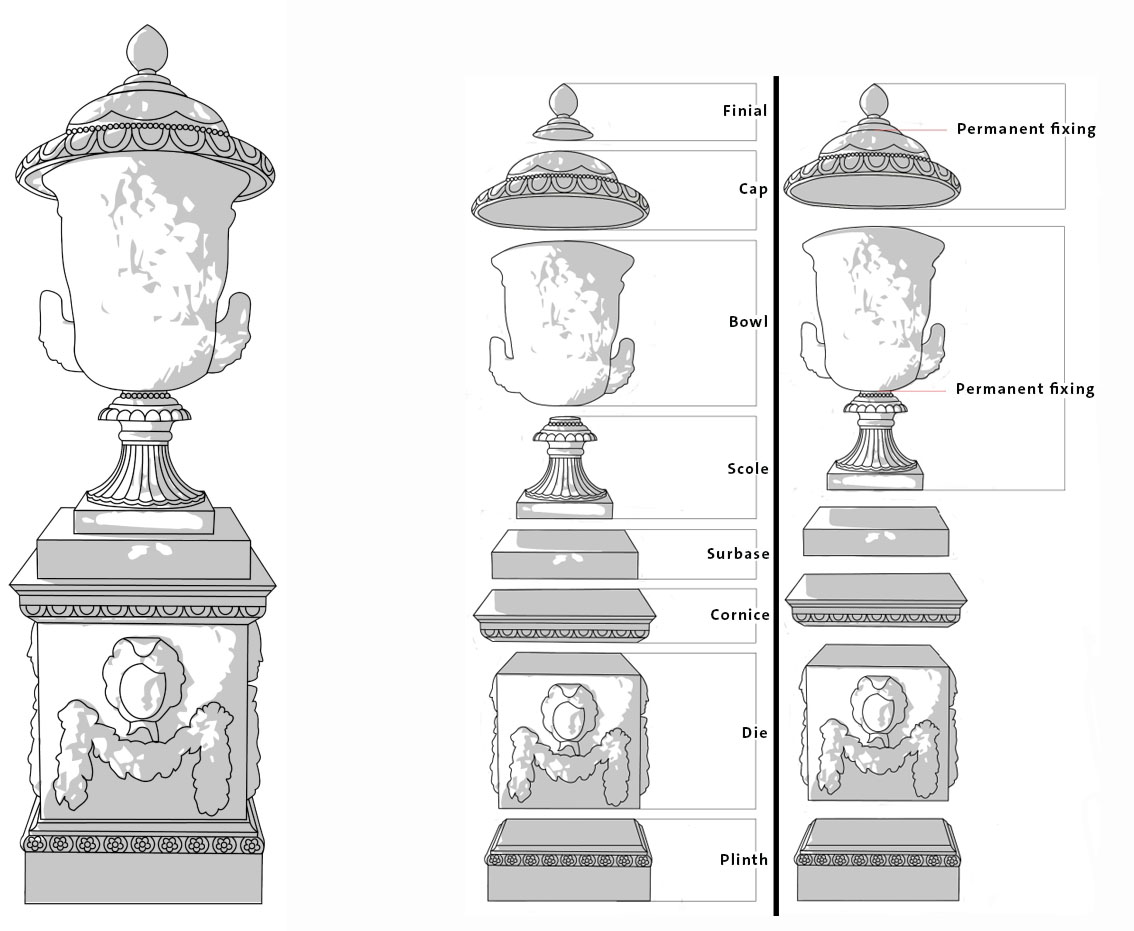
Finial and caps
The finial and caps are joined using wooden dowels and lead spacers covered with a layer of Polyfilla. The caps weigh 155 kilograms each, and were set on the bowls using Polyfilla and spacers to provide a narrow gap between the two parts. The caps had to be separated from the bowls before transit and packed separately.
Attempting to lift the caps manually was not an option as – due to their weight – the effort needed might have affected the stability of the bowls, which rest on narrow socles and could pose a risk of injury. Instead, bespoke timber lifting frames were produced for each urn cap providing sufficient support while lifting and preventing slings coming into direct contact with the object.
Before lifting we had to break the seal between the urn and the Polyfilla. The gaps between the caps and the bowls were too narrow to insert any tools, so Sculpture Conservation introduced a mixture of water and acetone into the gap and it was left for several hours to soften the Polyfilla.
Eventually the caps were lifted using the lifting frames and slings attached to a pedestrian forklift, and the urns were cleaned thoroughly.
Each cap was then packed into a crate on its lifting frame sitting on Plastazote foam and secured with several battens ready for transit.
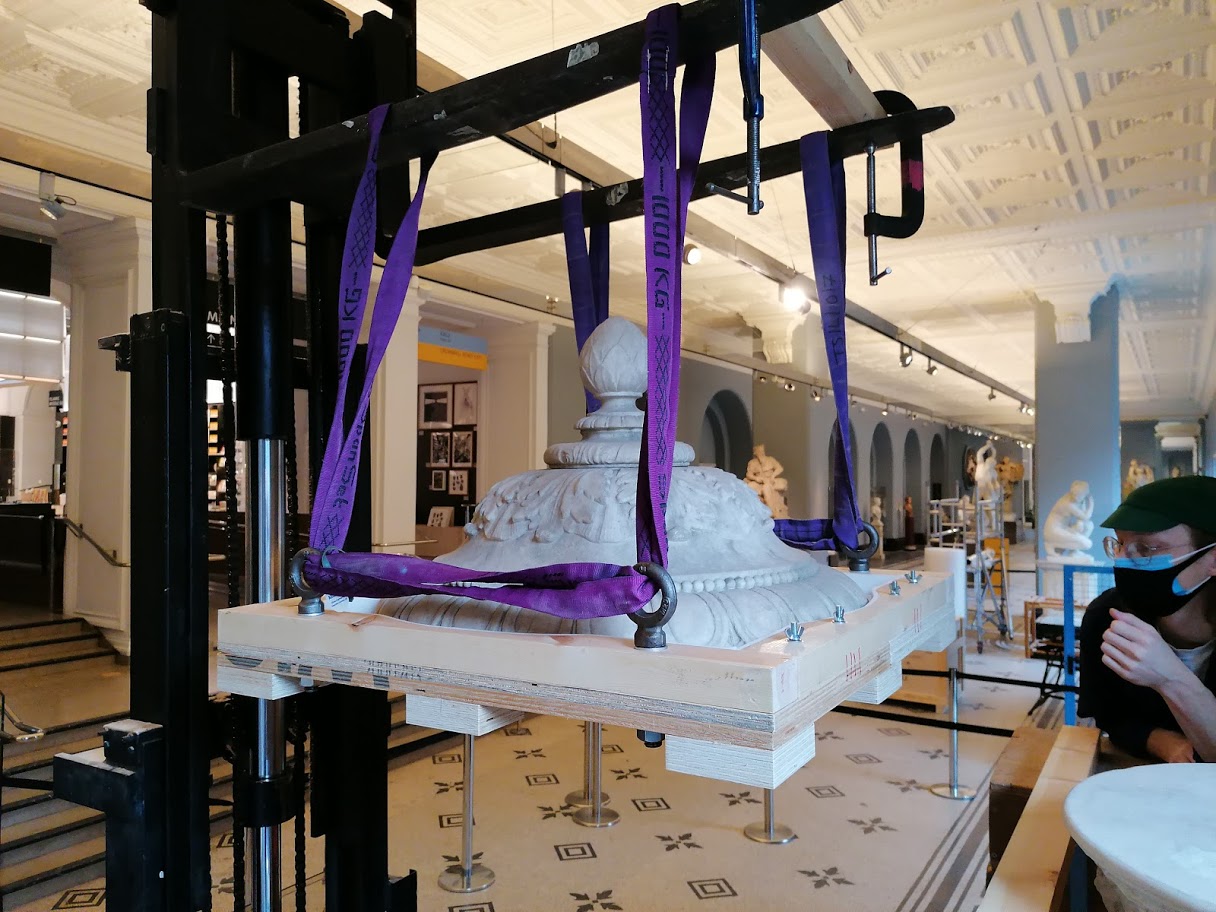
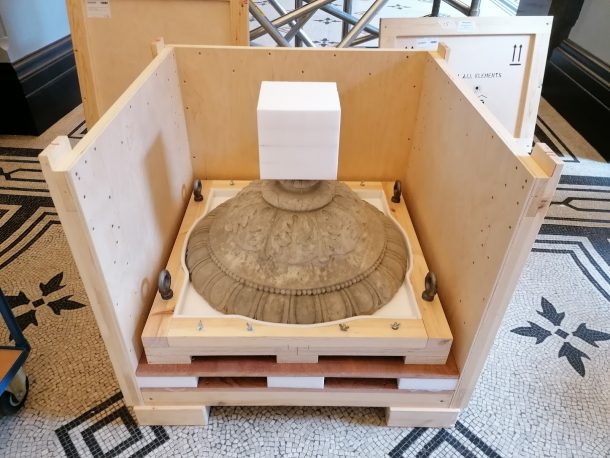
Bowl and Socle
The main bowls of the urns are joined to the socles using stainless steel square pins, which both locate them in the correct position and secure them. In 2006 Sculpture Conservation coated each pin in resin to secure the fixing, and lead shims were placed in between the two parts to allow room for filler.
This permanent fixing required special care when lifting as it is a weak point in the overall structure. The original lifting frame used when the urns were first installed was no longer suitable for use now that these two parts were joined, so another method needed to be introduced.
The urns were initially lifted using slings and the pedestrian forklift. The objects were wrapped in acid free tissue and Plastazote held in place with shrink wrap to prevent damage to the surface. A spreader bar was used to ensure the slings did not catch against the rim of the bowl.
Bespoke pallets were made to the internal dimensions of the crates to allow us to easily transfer the bowls and socles. The pallets were propped up to the same height using plywood boxes temporarily secured using battens.
The plywood boxes are historic equipment, made by one of our predecessors. They are a technician favourite and used regularly when we find it necessary to create a temporary platform the same height as an object, plinth, or case – particularly when it is crucial to slide an object rather than lifting.
Using the forklift, the bowls and socles were lifted very slightly, enough to clear the object from its base, and carefully lowered on to the nearby pallet ready to be crated.
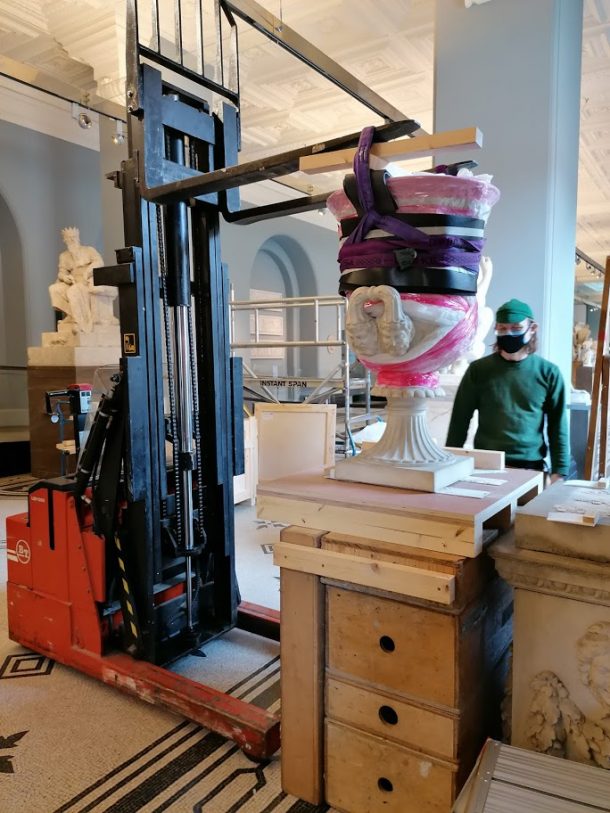
Surbase and Cornice
Each surbase and cornice is separated by lime mortar and lead spacers to protect the surfaces of the two parts. This provided a weak bond, which needed to be loosened to separate the surbase and cornice for packing. Each of the surbases were manually slid off the cornices using Teflon slides on to a dandy to be transferred into their crates.
The cornice was transferred using the same method, and the two parts were stacked in the same crate to reduce the crate footprint.
One of the surbases, however, was particularly stubborn – and the lime mortar provided a particularly strong bond, so rather than risking any damage to the object by separating it we decided to pack it as one unit.
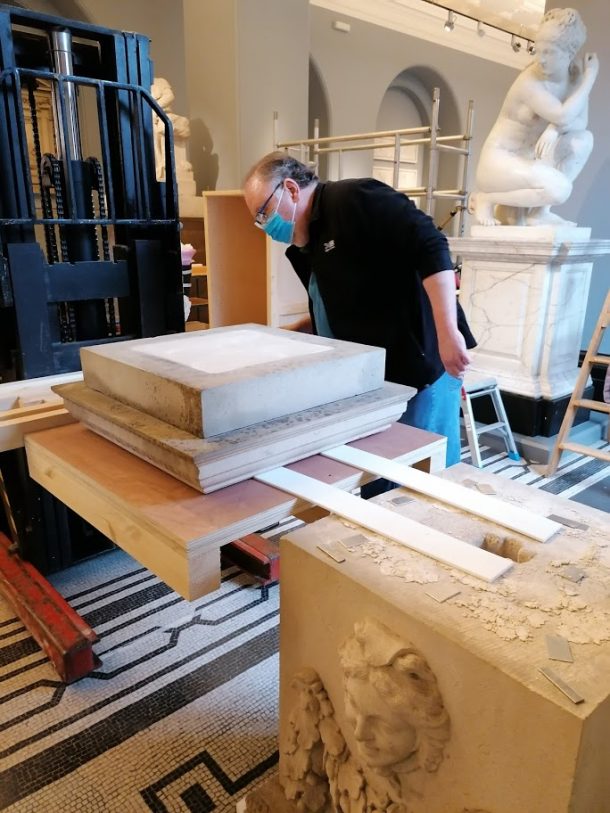
Pedestal Die
The dies are the heaviest part of the objects, weighing between 400 – 500 kilogrammes each, so moving them manually was impossible.
Instead, we attached 3 Teflon slides to a large pallet raised on timbers to leave us room to place slings under the objects. This was secured in position using a ratchet strap and a secondary pedestrian forklift was placed between the pallet and the larger forklift to act as a weight to prevent any movement.
The dies were pulled on to the Teflon slides with the forklift using slings joined with D-rings and a length of 4×3 timber at the back, acting as an extender to prevent the slings encountering any of the fragile details on the object. It was then possible to place slings under the base of the dies to lift and transfer them into their crates.
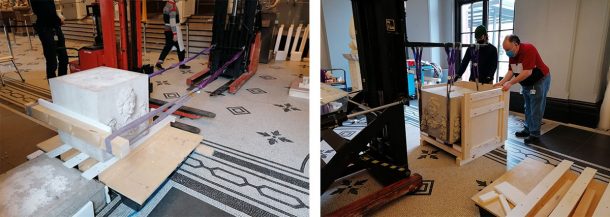
Pedestal Plinths
Finally, the plinths were also lifted using a similar method, the objects were wrapped in Plastazote secured with a ratchet strap. We could then attach two slings to the front two corners hooking them under the ratchet strap. The object could then be tilted, and Teflon wedges inserted underneath.
This method is a modern, more conservation safe adaption of the wooden wedges lathered in soap that were once used in museums to manipulate and manoeuvre heavy objects.
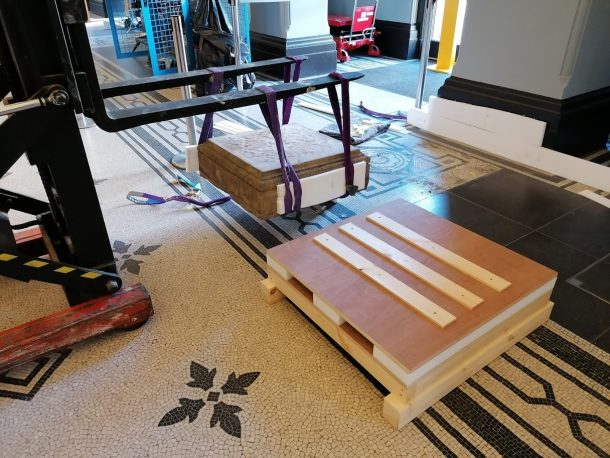
The object was then lowered down on to the wedges providing a gap deep enough to slide in two slings. The plinths were then lifted using these slings with the forklift into its crate.


